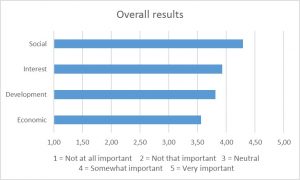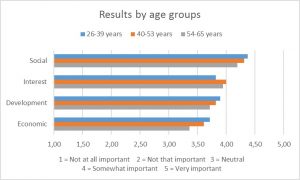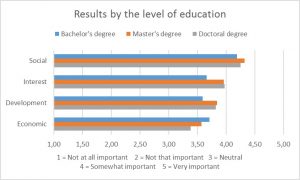The high-quality workforce of Finnish higher education institutes value most the social dimension of work
The psychological contract between employees and their employers has changed: instead of having a lifetime employment in a firm, it is more common nowadays to change jobs and have multiple workplaces during your career. Furthermore, there are more high-quality jobs available than there are suitable seekers to fill those places. These factors have created new challenges for firms: how to attract and retain highly skilled employees, referred to as high-quality workforce, when there is competition for the same human resources. In the spring of 2017, this study examined what factors the high-quality employees of Finnish higher education institutes value the most when they are considering potential employers. The study found out that social factors of work are the most valued. This blogpost shares the results of the study and offers development ideas on how to attract and retain high-quality workforce.
New expectations towards work
The change in the psychological contract has created a need for employers to find new ways to attract and retain high-quality employees. Traditionally, the concept of psychological contract between employers and employees meant that employees promised to be loyal to the firm in exchange for securing of a job. Workplaces of today are different driven by globalization and the increased usage of technology. As new generations are entering the working life, the workplace demographics are becoming more diverse than ever. Recent trends such as outsourcing, downsizing, and flexibility from the side of the employer have created a new form of a psychological contract where employers offer career-enhancing skills for employees through training and development, and in return, they expect flexibility and effort. These new expectations have the possibility to create uncertainties towards attracting and retaining talented and skilled employees in the workplace, and they raise questions about whether we truly understand the expectations that employees have towards work.
The study
The Finnish education system and its high quality are well known. The high quality of education indicates that there must be high-quality workforce working in the industry. In fact, educational faculty, who are key players to the quality of education, must have a higher education degree. The minimum requirement is a master’s degree at universities of applied sciences, and the norm is a doctoral degree at universities. The current study offered an opportunity to understand the interests and values of the high-quality employees in these institutes related to working. The results provide insights to Finnish higher education institutes and their human resource management about the factors that high-quality employees value when they are considering potential employers. With the knowledge received from this study, these institutes can become more attractive and wanted employers among the high-quality workforce in the field of education.
The study grouped the factors of employer attractiveness under four dimensions following prior research on the topic, namely social, interest, development and economic dimensions. Social factors measure fun at work, a positive and happy working environment based on good relationships with colleagues, supportive and encouraging colleagues, and the feelings of acceptance, belonging and respect. Interest factors imply for example that the employer has a good reputation in the public, it has a positive future-outlook, it is innovative, it is international, and it offers meaningful and interesting work. Development factors look into the development opportunities provided by the employer such as a clear career path, work-related training opportunities, varying work assignments, career-enhancing experiences, and internationalization possibilities. Finally, economic factors measure the attractiveness of financial benefits such as a competitive salary, job stability and security, performance-based incentives, fringe benefits that are non-monetary, and paid vacation. The empirical study was an online survey conducted with 159 respondents including both teaching and administrative staff from 11 different universities and universities of applied sciences.
Factors valued by high-quality workforce in Finnish higher education institutes
Figure 1 presents the overall results. This study found out that the social factors are the most valued. This means that when the high-quality workforce of Finnish higher education institutes is considering potential employers, they value a workplace that has a positive and happy working environment. There are good relationships among supportive and encouraging colleagues, people are accepted, and they have fun at work. Moreover, it is important that the employer values and respects the employees. After the social factors came the interest factors, followed by the development factors, and the economic factors were the least valued. The differences are statistically significant based on one-sample t-tests (p=0.00).
Figure 1. Overall results
There were no statistically significant differences in the results either by gender or by the type of employees (teaching vs. administration). The results between age groups showed few differences (see Figure 2). In economic, development and social factors, the importance of the factors decreases when the age of the respondents’ increases. This could result from the fact that when getting older, work itself can become less important in life. Another difference is in the interest factors. For respondents aged 40-53 years, the interest factors are more important than for the other two groups. For them, this could result from the fact that there can be other duties (e.g., family) outside work too. In order to manage work and other duties, the work needs to be interesting.
Figure 2. Results by age groups
The importance of the economic factors decreases when the level of education increases (see Figure 3). In addition, for the respondents with a bachelor’s degree, the economic factors are the second most valued. These differences, which are statistically significant based on the t-tests, can result from the differences between the salaries of the workforce in each level of education. With a bachelor’s degree, the amount of salary is less than with a doctoral degree. Therefore, the respondents with a bachelor’s degree might value the economic factors more.
Figure 3. Results by the level of education
What should the Finnish higher education institutes do?
When attracting and retaining high-quality employees, Finnish higher education institutes should invest on the social dimension. They should spare their efforts to create a positive and happy working environment where employees support and encourage each other. It is important to show in action that the employees are accepted, valued and respected in the working community. Having fun at work would also contribute to the innovative spirit among the high-quality workforce. “Meaningful and interesting work” was the most valued interest factor, and “varying working assignments” was the most valued development factor. If the higher education institutes offer varying working assignments for their employees that serve the needs and challenges of the society, the work itself could become more interesting. Considering these two factors as a joint force would help the institutes to attract and retain high-quality employees.
Emmi Matila, International Business student from JAMK University of Applied Sciences, School of Business, emmi.matila (at) gmail.com


